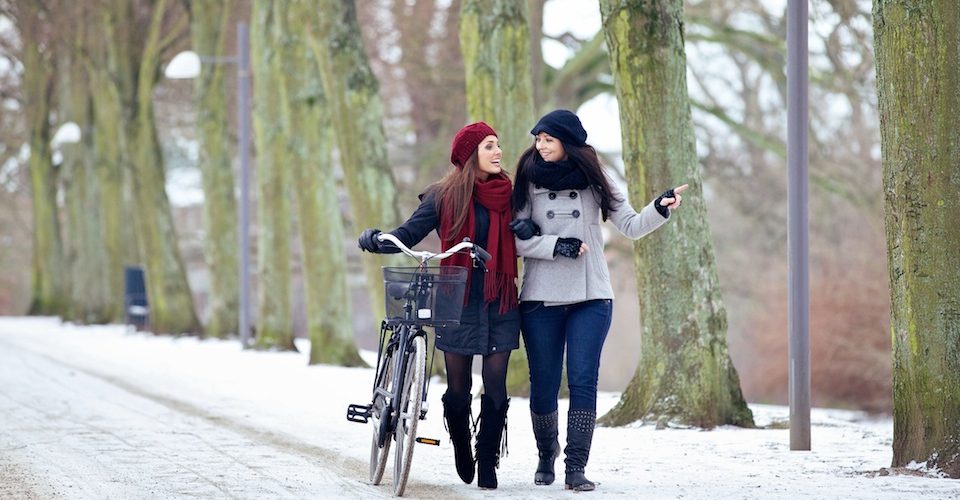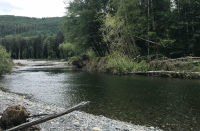Winter cycling is no longer the domain of daring bicycle couriers or mountain biking aficionados. With rising gas prices, environmental footprint concerns, and improved infrastructure for city riding, commuting by bicycle year-round is a growing trend. “We’re seeing more and more people out there,” says Yvonne Bambrick, spokesperson for the Toronto Cyclists Union, an advocacy organization, who cycles through the year.
Winter cycling is no longer the domain of daring bicycle couriers or mountain biking aficionados. With rising gas prices, environmental footprint concerns, and improved infrastructure for city riding, commuting by bicycle year-round is a growing trend. “We’re seeing more and more people out there,” says Yvonne Bambrick, spokesperson for the Toronto Cyclists Union, an advocacy organization, who cycles through the year. She likens winter biking to skiing or ice-skating: an enjoyable winter pastime. Debbie Field, the 56-year old executive director of FoodShare, a food security organization, agrees: “It’s like cross-country skiing and mountain biking all rolled into one.” She enjoys the fresh air, the exercise, and the challenge of navigating through snowy streets, and calls her commute into work “the best part of my day!”
Have you ever been stranded in a transit shelter, stamping your feet to keep warm, enviously watching the cyclists sailing by? Well, here’s what you need to know to make the switch. But first, let’s clear up some common misconceptions:
#1 – Is it safe? Although more caution is required, biking in the winter is no more dangerous than driving. “If you can drive it, you can ride it” says Bambrick of snowy weather conditions, advising riders to take the same precautions they would if they were driving – leave yourself ample time to arrive at your destination, ride cautiously and defensively, and check the weather forecast beforehand you set out. Toronto Police Constable Mig Roberts of Traffic Services also reminds riders to be hyper-aware of their surroundings, such as icy bridges, streetcar tracks, and large snow banks. “Be aware that when approaching an intersection, you may be obscured from motorists by snow banks.” He reports that November seems to be the winter month with the most spills, as riders adjust to the transition into winter. He also says that riders will be in good shape “as long as [they] remember that they’re vehicles too, and obey the rules of the road.”
#2 – Isn’t it too cold? Contrary to what you might expect, one of the biggest challenges with winter biking is how to stay cool. Bambrick dresses more lightly for cycling to work than she would if she was taking transit. “You warm yourself up when riding – and it’s far warmer to get on your bike and get going on your own schedule than freezing waiting for the bus!” She swears by ear muffs and leg warmers. Debbie Field adds that snow pants, big gloves, and good boots are worth investing in as well.
#3 – Will I like it? Most winter cyclists report their commute as uplifting, and setting a positive tone for the day ahead, versus arriving at work after being packed in with other unhappy commuters. The side benefits of biking are numerous – you start your day with a free workout, you’re not subject to the whims of traffic or public transit, and you save money.
As winter cycling continues to grow in popularity, infrastructure and accessibility for cyclists will also continue to improve. Cities such as Montreal, Calgary, Ottawa and Toronto are making efforts to clear bicycle paths in winter, and many businesses now provide employees with showers and convenient bike parking. All that’s left is for people to take the plunge, and experience the joys of winter cycling. Asked what she would say to hesitant would-be bikers, Field smiles and says: “Try it! You WILL like it!”
Get in Gear
Remember that all you really need is a sturdy ride and warm layers, but sometimes a few add-ons can make the world of difference. Try out these highly-recommended items for a more comfortable winter biking experience.
Tires: Regular bike tires will generally get you through winter. But for snowy days, consider investing in mountain-bike style tires for extra traction. If you’re feeling really hardcore, and are mostly riding in icy conditions, spring for winter tires (yes, they make winter tires for bikes, too), such as these studded tires from Schwalbe. (Caution: These are for extreme conditions only!) If you can only afford one tire, opt for replacing the front one for optimal control. Also consider some sort of fender – Toronto Police actually recommend against traditional fenders, where snow and slush can accumulate underneath. Instead, consider a higher clip-on fender, or even a rear rack with a strip of plywood attached.
Head and Eye Protection: It goes without saying that you should invest in a top quality helmet, especially one that offers ear protection and attachments for goggles as well as a bell, to help you be heard on the road when you aren’t seen. Let’s face it, if you bike in the snow you’re going to get slush in the face. Specialized eye gear is a must. A favourite of some riders (including Bambrick) are the “blade” style sunglasses with clear frames. I personally prefer ski-goggles – they’re tough, practical and don’t fog up.
Clothing: A barrier for some commuters is the perceived inconvenience of having to carry an extra outfit to work. In my experience, this is only the case if there’s an extra-special presentation or meeting – I can usually get away with wearing my workday clothes on the commute, under some warm, breathable layers, and a waterproof-breathable shell.
Panniers: When you’re navigating city streets, the last thing you want is weight on your back. A rear rack and waterproof panniers are a must for carrying your gear back and forth. Bonus: Extra capacity to stop for groceries on the way home.
Lights: With fewer daylight hours in the winter, you’ll want bright front and rear lights for your bike; reflective tape on your frame will help motorists see you that much better.
Winter Toolkit: As well as your usual patch kit and bike grease, consider throwing in a lighter or lock de-icer in case your bike lock freezes up. And don’t forget a winter tune-up to make sure your bike is ready for the snow.
Green Living Online is a property of Green Living Enterprises, a full-service, one-stop solution for environmental and cause marketing. Our services include product and program development, custom publishing and event marketing. Green Living Enterprises also includes the Green Living Show, North America’s largest consumer show dedicated to living a healthy and sustainable lifestyle.













